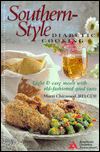I recently returned from a morning appointment full of fresh "Spring is in the Air" enthusiasm. We were having one of those rare, it's-still-winter days on the West Coast, the kind that plays tag with your senses and teases you into believing you can do anything - even exercise!
We (diabetics) all know how important good nutrition (and exercise) are for good glucose control. According to an ADA spokesperson, however, most consumers think of nutrition as a matter of rules and denial, and that good healthy eating takes too much time to prepare. With more than 55% of our nation classified as obese, and childhood obesity leading to never before numbers of Type 2 diabetes in children, the experts are alarmed. This means that a child who develops Type 2 diabetes can reap the harvest of diabetic complications, such as heart attack and stroke, as early as his or her 30's!
Lifestyle changes - such as better eating - come in stages, and you'll be a lot more successful if you start small. Small stage examples would be planning and shopping ahead for meals, or eating smaller portions, or making your changes enjoyable, such as adding new foods to your menu.
Most of us will be facing several celebrations this Spring: St. Patrick's Day, Passover, Easter, Cinco de Mayo, Mother's Day, Father's Day and assorted graduations and weddings. All are food-focused and, for the diabetic, will always present a challenge. If you need a little more motivation to get you started in the direction of a healthier lifestyle, then think about adding some new foods or recipes to your collection. Visit your local library and check out some of the cookbooks described below - or go to your local bookstore (or Amazon.com) to browse through them or order them. I guarantee that your pocketbook and your body will thank you for it!

I had a great time spending my Christmas cash gifts this past post-holiday season, and one of my best finds was DIABETIC DESSERTS, by Betty Wedman, Ph.D., R.D. (Ms. Wedman, past president of the American Association of Diabetes Educators, also authored the best-selling Quick & Easy Diabetic Menus).
In Diabetic Desserts, Betty Wedman offers people with diabetes more than 80 delicious and easy-to-follow recipes for desserts that are good-tasting and health-conscious. I found myself in a full-faced grin as I read her dedication, "To all those individuals with diabetes who thought I was unscientific when I told them to use sugar instead of sugar substitutes in their recipes." She bases her statement position on the most recent ADA guidelines which state that ". . . scientific evidence has shown that the use of sucrose as part of the meal plan does not impair blood glucose control in individuals with Type 1 and Type 2 diabetes."
You can enjoy a wide variety of rich-tasting, delicious recipes for cookies, cakes, muffins and quick breads, pies, tarts and tortes, puddings and custards, crumbles and cream puffs, snacks, sauces and sorbets, as well holiday favorites and dessert beverages in this neat little cookbook. Wouldn't you just love a taste of Cappuccino Pudding Cake, or a bite of a Macadamia White Chocolate Cookie? How about Cookies and Cream Cheesecake, Chocolate Swirl Brioche, or some Lemony Bread Pudding? If you have a sweet tooth as fine-tuned as mine, don't miss this wonderful dessert book. I highly recommend it!
Diabetic Desserts, by Betty Wedman, Ph.D., R.D., � 1996, published by Contemporary Books, $12.95 (or order now for only $10.36 at Amazon.com)
 THE NEW SOUL FOOD COOKBOOK FOR PEOPLE WITH DIABETES, by Fabiola Demps Gaines, RD, LD, and Roniece Weaver, MS, RD, LD, is the first African American cookbook for people with diabetes. We missed a great window of opportunity for its presentation during Black History Month, but that doesn't mean we can't enjoy it all year long!
THE NEW SOUL FOOD COOKBOOK FOR PEOPLE WITH DIABETES, by Fabiola Demps Gaines, RD, LD, and Roniece Weaver, MS, RD, LD, is the first African American cookbook for people with diabetes. We missed a great window of opportunity for its presentation during Black History Month, but that doesn't mean we can't enjoy it all year long!
We're given lots of historical background in the tradition of African American cookery in the introduction to this delicious cookbook. According to the authors, when the first slaves arrived in Virginia around 1619, common African-American foods included rice, beans, cornmeal, black-eyed peas, sweet potatoes, greens and onions. Foods were usually flavored with meat scraps (usually "fatback" from hogs), chiles from the Caribbean and molasses. Although diets were predominantly vegetarian, with some fish, possom or squirrel for flavor, foods were boiled, fried, roasted or baked. Stews and thick gumbos, liberal use of molasses, and fat-laden gravies provided calories. African Americans used salt and sweeteners in abundance, suffering no ill effects from the excess due to the countless hours spent in hard manual labor.
Both Fabiola Gaines and Roniece Weaver have been personally touched by diabetes in close family relatives: Fabiola's father was diagnosed after a heart attack, and Roniece's father after exhibiting fatigue, blurry vision, and an insatiable craving for sweets. (Note: according to 1998 statistics, African-Americans have the highest incidence of diabetes in the US, by ethnicity).
With compassion, determination and dedication, Gaines and Weaver used their personal experience with diabetes to make a difference in their community by teaching African Americans how to avoid hypertension, heart disease and diabetes by making easy changes to traditional soul food recipes, without sacrificing flavor. Now you can experience healthier versions of your favorite soul foods such as Barbecue Pulled Pork, Hoppin' John, Hoe Cake, Soul Slaw, Collards with Smoked Turkey, Chicken and Dumplings, Key Lime Pie, Sweet Potato Pound Cake and more.
The New Soul Food Cookbook not only incorporates the basics of healthy food preparation and menu planning with suggestions for cooking with traditional herbs and spices, but there is plenty of good advice for reducing fat, calories and sodium. Each recipe includes the portion size, as well as complete nutritional information and official ADA exchanges. The New Soul Food Cookbook, published by the American Diabetes Association, � 1999, $14.95. (or order now for only $11.96 at Amazon.com)
 He's back! Alan L. Rubin, M.D., who authored Diabetes For Dummies, has now teamed up with Fran Stach, R.D., C.D.E., and Chef Denise Sharf to produce the DIABETES COOKBOOK FOR DUMMIES. This new cookbook sets out to dispel one of the most common myths about diabetes, which is that people who have diabetes can't eat "regular" food.
He's back! Alan L. Rubin, M.D., who authored Diabetes For Dummies, has now teamed up with Fran Stach, R.D., C.D.E., and Chef Denise Sharf to produce the DIABETES COOKBOOK FOR DUMMIES. This new cookbook sets out to dispel one of the most common myths about diabetes, which is that people who have diabetes can't eat "regular" food.
In addition to more than 100 delicious recipes and great advice you can use at every meal, Dr. Rubin has included sections on Building a Healthy Lifestyle, Eating Out, and a section titled The Part of Tens: Ten Simple Steps to Improve Your Diet; Ten Easy Substitutions in Your Eating Plan; Ten Strategies To Normalize Your Blood Glucose and Ten Tactics for Teaching Children with Diabetes Healthy Eating Habits.
For me, one of the most useful sections of the book was information on how to take a recipe nutritional analysis and manually calculate the dietary exchanges (Starches, Proteins, Fats, Milk, Fruit and Vegetables). This is found at the end of Part 1: Building a Healthy lifestyle. In my experience, I've run across many great healthy recipes, complete with nuitritional analysis, but lacking the dietary exchanges so necessary for those diabetics who need to know the exchanges per serving. I plan to reprint this formula as standing information on my Cinnamon Hearts website.
As usual, Dr. Rubin and his team have done an outstanding job in the recipe department, too. Lots of good information on ingredients, creating balanced meals and adding desserts to the diabetic meal plan, as well as the benefits of breakfast, eating out and fast food tips. This book is also a fine teaching tool if your talents in the kitchen are lacking finesse. Recommended. The Diabetes Cookbook For Dummies, by Alan L. Rubin, M.D., � 2000, published by IDG Books, $19.99. (or order now for only $15.99 at Amazon.com)
 SOUTHERN-STYLE DIABETIC COOKING, by Marti Chitwood, RD, CDE, has been sitting on my shelf, just begging to be reviewed for quite some time. Published by the American Diabetes Association in 1996, this collection of Southern comfort foods turned into good-for-you recipes, will be one you come back to over and over again.
SOUTHERN-STYLE DIABETIC COOKING, by Marti Chitwood, RD, CDE, has been sitting on my shelf, just begging to be reviewed for quite some time. Published by the American Diabetes Association in 1996, this collection of Southern comfort foods turned into good-for-you recipes, will be one you come back to over and over again.
Southern cooking has roots in many cultures. Pork and corn were two early Southern staples, and Africans introduced okra, black-eyed peas, collard greens, yams, sesame seeds, watermelon and other fruits and vegetables. Hot and sweet peppers, peanuts, tomatoes, lima beans, chocolate, white potatoes and sweet potatoes were brought from Central and South American and from China came oranges and peaches. The West Indies contributed peppers and fruits.
Southerners became very inventive and resourceful during the Civil War and reconstruction. People had to make-do with roots, beans, vegetation and game. Cabbage, okra, greens, pumpkins, squash, field peas, pokeweed, corn, nuts and berries became the foundation of Southern cooking.
One feature I really appreciate about this cookbook, are the tips on cutting the fat, what kinds of substitutions to make for rich dairy products, how to reduce the sodium (salt) in your cooking and how to add more fiber to your recipes. All of these suggestions are adaptable to just about any style of cooking. I especially agree with author Chitwood's theory that ". . . it's not necessary to give up desserts entirely --- just enjoy fresh fruit whenever possible and include richer desserts in your meal plan occasionally." She also recommends planning in advance to fit a dessert into your meal plan (sound familiar?), have small portions of a dessert, and adjust for the added calories, carbs and fat by cutting down in the rest of the day's meals. Getting plenty of exercise will also help to offset your special treat(s).
If Country Ham with Redeye Gravy, Blueberry Buttermilk Muffins, Pecan Waffles, Oven-Fried Green Tomatoes, Corn Pudding, Southern Fried Chicken, Red Beans, Ham & Rice, Low-Country Crab Cakes, Mississippi Mud Cake, Date-Nut Sour Cream Pound Cake or Carolina Rice Pudding cry out to your palate, then you absolutely MUST get your hands on a copy of Marti Chitwood's Southern-Style Diabetic Cooking! All recipes include the serving size and a complete nutritional analysis with ADA Exchanges per serving.
A great comfort food cookbook for diabetics; highly recommended. Southern-Style Diabetic Cooking, by Marti Chitwood, RD, CDE, � 1996, published by the American Diabetes Associaton, $11.95. (or order now for only $9.56 at Amazon.com)
 I recently discovered yet another very good book on diabetic cooking, tucked away in a stack of books I'd researched for a Mother's Day piece for the Cinnamon Hearts website last year (Hmmmm . . . must be about time to clean up and reorganize)!
I recently discovered yet another very good book on diabetic cooking, tucked away in a stack of books I'd researched for a Mother's Day piece for the Cinnamon Hearts website last year (Hmmmm . . . must be about time to clean up and reorganize)!
EVERYDAY COOKING FOR DIABETICS, by Stella Bowling, is a completely up-to-date cookbook using the newly revised nutritional guidelines based on the latest research findings. Author Bowling presents a detailed intruduction explaining the basics about diabetes, and addresses such topics as the principles of healthful eating, how to mantain a healthful weight and how to meet special challenges such as dining out and adapting favorite family recipes. (And once you get the hang of adapting your favorite recipes, you're home free in my book!)
The recipes (over 200 of them) are very easy and don't send you to specialty stores for unusual ingredients. Since I love personal anecdotes about the authors' recipes, I was happy to find they are plentiful in Everyday Cooking For Diabetics. There are also excellent side bar menu suggestions, a little food history, ingredient information, and cooking tips. All give a special flavor to this book which reflects the cook's passion for her art!
I'm eager to try the Raspberry Trifle, Normandy Apple Flan, a great recipe for Tiramisu, and some old-fashioned Date-and-Apricot Bars (wonder why I always seem to drift toward the desserts first?) There's a good section of Vegetarian recipes as well as a special on Holiday cooking at the end of the book. This is a book for cooks of all levels, and you really can't go wrong with these imaginative, creative recipes. It certainly proves our mantra that "A diagnosis of diabetes is NOT a culinary death sentence!" Or, more loosely translated: "Eating healthy really CAN taste good!"
Everyday Cooking For Diabetics, by Stella Bowling, contains a wide range of recipes suitable for the whole family, and each recipe comes with a complete nutritional analysis and Dietary Exchanges. Published by Fisher Books, � 1997, $15.95 (or order now for only $12.79 at Amazon.com). Do yourself a favor and check it out!
Well folks, that's the end of this installment of reviews. Look for the next batch of reviews later this Spring. In the meantime, this editor has the formidable task of updating the Cinnamon Hearts website (which has been patiently waiting for a face-lift while the Helton family struggled to overcome a number of health challenges).
You are invited to visit the Cinnamon Hearts website right now for some sample recipes from my current book reviews. When you arrive, just click on "Sample Recipes" in the sidebar - and set your tastebuds for some serious sampling!
Until next time, remember to stay focused in the present, because every moment is a gift!
Marilyn Helton








